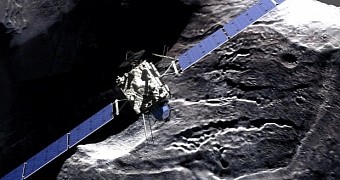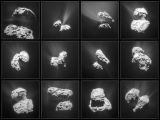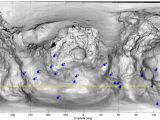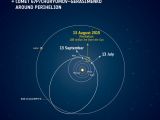Last night was especially busy for astronomers at the European Space Agency. At 02:03 GMT in the morning, right on schedule, Comet 67P/Churyumov-Gerasimenko swooped past the Sun and came within merely 186 million kilometers (roughly 115 million miles) of the fiery orb.
The European Space Agency's Rosetta probe, which has been orbiting the comet since last year's August, witnessed the encounter, as did the Philae lander, nestled atop 67P/Churyumov-Gerasimenko since last November.
Its approach to the Sun pushed the comet into overdrive
The Rosetta spacecraft caught up with Comet 67P/Churyumov-Gerasimenko on August 6, 2014. The probe and its target, together with Philae, have since journeyed around 750 million kilometers (nearly 470 million miles), following the comet's orbit towards the Sun.
When it reached Comet 67P/Churyumov-Gerasimenko over a year ago, the Rosetta probe documented an outflow of water vapor from its surface. As the comet moved closer and closer to the Sun, this outflow intensified.
At perihelion, i.e. the moment it made its closest approach to the Sun, the comet was producing the equivalent of two bathtubs of water per second, way more than when Rosetta first had a chance to have a close look at it.
European Space Agency astronomers say 67P/Churyumov-Gerasimenko is still spewing out massive amounts of water vapor and will continue to do so for several weeks to come, until it begins to cool down. Once cooled, it will return to its usual calm self.
“Rosetta’s measurements suggest the comet is spewing up to 300 kilograms [660 pounds] of water vapor - roughly the equivalent of two bathtubs - every second. This is a thousand times more than was observed this time last year when Rosetta first approached the comet.”
Apart from water vapor, the comet is producing about 1,000 kilograms (around 2,200 pounds) of dust per second. The vapors and the dust are released into space in the form of outbursts. Check out the gallery below for photos of such events.
Both the water vapor and the dust released by Comet 67P/Churyumov-Gerasimenko these past few months have added to its tail, which now measures an impressive 120,000 kilometers (almost 75,000 miles) in length.
So, what's next for Rosetta, Philae and the comet?
Comet 67P/Churyumov-Gerasimenko will go on circling the Sun for many years to come. As for the Rosetta probe and the Philae lander, it'll be lights out in a few months.
Mission scientists expect Rosetta will go on orbiting the comet until next year's September, after which it will descend onto its surface and zone out. As for Philae, the lander will too eventually run out of power and so will too end its mission.

 14 DAY TRIAL //
14 DAY TRIAL // 






